A Framework for Calculating Peak Discharge and Flood Inundation in Ungauged Urban Watersheds Using Remotely Sensed Precipitation Data: A Case Study in Freetown, Sierra Leone
Abstract
:1. Introduction
2. Study Area
3. Materials and Methods
3.1. Precipitation Analysis
3.2. Land Use/Land Cover Scenarios
3.3. Peak Discharge Analysis
3.3.1. Curve Number and Lag Method
3.3.2. Curve Number and Graphical TR-55
3.3.3. Rational Method
3.4. SWAT Precipitation and Peak Runoff Generation
3.5. HEC-RAS Setup
3.6. Geospatial Analysis
4. Results
4.1. Precipitation Analysis
4.2. Land Use/Land Cover Scenarios
4.3. Peak Runoff Analysis
4.4. Inundation Areas and Affected Infrastructure and Population
4.5. Inundation Boundary Validation
5. Discussion
5.1. Precipitation Analysis
5.2. Land Use/Land Cover Scenarios
5.3. Runoff Calculations
5.4. Inundation Estimations
6. Conclusions
Supplementary Materials
Author Contributions
Funding
Institutional Review Board Statement
Informed Consent Statement
Data Availability Statement
Acknowledgments
Conflicts of Interest
References
- United Nations; Department of Economic and Social Affairs; Population Division. World Population Prospects 2019: Highlights; UN: New York, NY, USA, 2019; ISBN 978-92-1-148316-1. [Google Scholar]
- Ahiablame, L.M.; Engel, B.A.; Chaubey, I. Effectiveness of Low Impact Development Practices: Literature Review and Suggestions for Future Research. Water Air Soil Pollut. 2012, 223, 4253–4273. [Google Scholar] [CrossRef]
- Blair, A.; Sanger, D.; White, D.; Holland, A.F.; Vandiver, L.; Bowker, C.; White, S. Quantifying and Simulating Stormwater Runoff in Watersheds: STORMWATER RUNOFF IN WATERSHEDS. Hydrol. Process. 2014, 28, 559–569. [Google Scholar] [CrossRef]
- Weng, Q. Modeling Urban Growth Effects on Surface Runoff with the Integration of Remote Sensing and GIS. Environ. Manag. 2001, 28, 737–748. [Google Scholar] [CrossRef] [PubMed]
- Sheng, J.; Wilson, J.P. Watershed Urbanization and Changing Flood Behavior across the Los Angeles Metropolitan Region. Nat. Hazards 2009, 48, 41–57. [Google Scholar] [CrossRef]
- Suriya, S.; Mudgal, B.V. Impact of Urbanization on Flooding: The Thirusoolam Sub Watershed—A Case Study. J. Hydrol. 2012, 412–413, 210–219. [Google Scholar] [CrossRef]
- Rogger, M.; Agnoletti, M.; Alaoui, A.; Bathurst, J.C.; Bodner, G.; Borga, M.; Chaplot, V.; Gallart, F.; Glatzel, G.; Hall, J.; et al. Land Use Change Impacts on Floods at the Catchment Scale: Challenges and Opportunities for Future Research: Land Use Change Impacts on Floods. Water Resour. Res. 2017, 53, 5209–5219. [Google Scholar] [CrossRef] [PubMed] [Green Version]
- Saldarriaga, J.; Salcedo, C.; Solarte, L.; Pulgarín, L.; Rivera, M.L.; Camacho, M.; Iglesias-Rey, P.L.; Martínez-Solano, F.J.; Cunha, M. Reducing Flood Risk in Changing Environments: Optimal Location and Sizing of Stormwater Tanks Considering Climate Change. Water 2020, 12, 2491. [Google Scholar] [CrossRef]
- Li, L.; Jiang, C.; Murtugudde, R.; Liang, X.-Z.; Sapkota, A. Global Population Exposed to Extreme Events in the 150 Most Populated Cities of the World: Implications for Public Health. Int. J. Environ. Res. Public Health 2021, 18, 1293. [Google Scholar] [CrossRef]
- Eleutério, J.; Hattemer, C.; Rozan, A. A Systemic Method for Evaluating the Potential Impacts of Floods on Network Infrastructures. Nat. Hazards Earth Syst. Sci. 2013, 13, 983–998. [Google Scholar] [CrossRef]
- United Nations; Department of Economic and Social Affairs. World Social Report 2020: Chapter 3: Climate Change Exacerbating Poverty and Inequality; UN: New York, NY, USA, 2020; ISBN 978-92-1-130392-6. [Google Scholar]
- Mahmoud, S.H.; Gan, T.Y. Urbanization and Climate Change Implications in Flood Risk Management: Developing an Efficient Decision Support System for Flood Susceptibility Mapping. Sci. Total Environ. 2018, 636, 152–167. [Google Scholar] [CrossRef]
- Proag, V. The Concept of Vulnerability and Resilience. Procedia Econ. Financ. 2014, 18, 369–376. [Google Scholar] [CrossRef] [Green Version]
- Mohamed, S.A.; El-Raey, M.E. Vulnerability Assessment for Flash Floods Using GIS Spatial Modeling and Remotely Sensed Data in El-Arish City, North Sinai, Egypt. Nat. Hazards 2020, 102, 707–728. [Google Scholar] [CrossRef]
- National Research Council. Elevation Data for Floodplain Mapping; National Academies Press: Washington, DC, USA, 2007; p. 11829. ISBN 978-0-309-10409-8. [Google Scholar]
- Apel, H.; Aronica, G.T.; Kreibich, H.; Thieken, A.H. Flood Risk Analyses—How Detailed Do We Need to Be? Nat. Hazards 2009, 49, 79–98. [Google Scholar] [CrossRef]
- Glas, H.; Deruyter, G.; De Maeyer, P.; Mandal, A.; James-Williamson, S. Analyzing the Sensitivity of a Flood Risk Assessment Model towards Its Input Data. Nat. Hazards Earth Syst. Sci. 2016, 16, 2529–2542. [Google Scholar] [CrossRef] [Green Version]
- Bates, P.D.; Wilson, M.D.; Horritt, M.S.; Mason, D.C.; Holden, N.; Currie, A. Reach scale floodplain inundation dynamics observed using airborne synthetic aperture radar imagery: Data analysis and modelling. J. Hydrol. 2006, 328, 306–318. [Google Scholar] [CrossRef]
- Aggett, G.R.; Wilson, J.P. Creating and Coupling a High-Resolution DTM with a 1-D Hydraulic Model in a GIS for Scenario-Based Assessment of Avulsion Hazard in a Gravel-Bed River. Geomorphology 2009, 113, 21–34. [Google Scholar] [CrossRef]
- Masser, I. Managing Our Urban Future: The Role of Remote Sensing and Geographic Information Systems. Habitat Int. 2001, 25, 503–512. [Google Scholar] [CrossRef]
- Boongaling, C.G.K.; Faustino-Eslava, D.V.; Lansigan, F.P. Modeling Land Use Change Impacts on Hydrology and the Use of Landscape Metrics as Tools for Watershed Management: The Case of an Ungauged Catchment in the Philippines. Land Use Policy 2018, 72, 116–128. [Google Scholar] [CrossRef]
- Rafiei Sardooi, E.; Azareh, A.; Choubin, B.; Barkhori, S.; Singh, V.P.; Shamshirband, S. Applying the Remotely Sensed Data to Identify Homogeneous Regions of Watersheds Using a Pixel-Based Classification Approach. Appl. Geogr. 2019, 111, 102071. [Google Scholar] [CrossRef]
- Radwan, F.; Alazba, A.A.; Mossad, A. Estimating Potential Direct Runoff for Ungauged Urban Watersheds Based on RST and GIS. Arab. J. Geosci. 2018, 11, 748. [Google Scholar] [CrossRef]
- Brivio, P.A.; Colombo, R.; Maggi, M.; Tomasoni, R. Integration of Remote Sensing Data and GIS for Accurate Mapping of Flooded Areas. Int. J. Remote Sens. 2002, 23, 429–441. [Google Scholar] [CrossRef]
- Klemas, V. Remote Sensing of Floods and Flood-Prone Areas: An Overview. J. Coast. Res. 2015, 314, 1005–1013. [Google Scholar] [CrossRef]
- Wang, Y. Advances in Remote Sensing of Flooding. Water 2015, 7, 6404–6410. [Google Scholar] [CrossRef]
- Hong, Y.; Adler, R.F.; Hossain, F.; Curtis, S.; Huffman, G.J. A First Approach to Global Runoff Simulation Using Satellite Rainfall Estimation: TECHNICAL NOTE. Water Resour. Res. 2007, 43. [Google Scholar] [CrossRef] [Green Version]
- Li, L.; Xu, T.; Chen, Y. Improved Urban Flooding Mapping from Remote Sensing Images Using Generalized Regression Neural Network-Based Super-Resolution Algorithm. Remote Sens. 2016, 8, 625. [Google Scholar] [CrossRef] [Green Version]
- Psomiadis, E.; Diakakis, M.; Soulis, K.X. Combining SAR and Optical Earth Observation with Hydraulic Simulation for Flood Mapping and Impact Assessment. Remote Sens. 2020, 12, 3980. [Google Scholar] [CrossRef]
- Khan, S.I.; Hong, Y.; Wang, J.; Yilmaz, K.K.; Gourley, J.J.; Adler, R.F.; Brakenridge, G.R.; Policelli, F.; Habib, S.; Irwin, D. Satellite Remote Sensing and Hydrologic Modeling for Flood Inundation Mapping in Lake Victoria Basin: Implications for Hydrologic Prediction in Ungauged Basins. IEEE Trans. Geosci. Remote Sens. 2011, 49, 85–95. [Google Scholar] [CrossRef] [Green Version]
- Wilson, J.P.; Gallant, J.C. (Eds.) Terrain Analysis: Principles and Applications; Wiley: New York, NY, USA, 2000; ISBN 978-0-471-32188-0. [Google Scholar]
- Sharif, H.O.; Al-Juaidi, F.H.; Al-Othman, A.; Al-Dousary, I.; Fadda, E.; Jamal-Uddeen, S.; Elhassan, A. Flood Hazards in an Urbanizing Watershed in Riyadh, Saudi Arabia. Geomat. Nat. Hazards Risk 2016, 7, 702–720. [Google Scholar] [CrossRef] [Green Version]
- Elaji, A.; Ji, W. Urban Runoff Simulation: How Do Land Use/Cover Change Patterning and Geospatial Data Quality Impact Model Outcome? Water 2020, 12, 2715. [Google Scholar] [CrossRef]
- Meresa, H. Modelling of River Flow in Ungauged Catchment Using Remote Sensing Data: Application of the Empirical (SCS-CN), Artificial Neural Network (ANN) and Hydrological Model (HEC-HMS). Model. Earth Syst. Environ. 2018, 5, 257–273. [Google Scholar] [CrossRef]
- Abdrabo, K.I.; Kantoush, S.A.; Saber, M.; Sumi, T.; Habiba, O.M.; Elleithy, D.; Elboshy, B. Integrated Methodology for Urban Flood Risk Mapping at the Microscale in Ungauged Regions: A Case Study of Hurghada, Egypt. Remote Sens. 2020, 12, 3548. [Google Scholar] [CrossRef]
- Belayneh, A.; Sintayehu, G.; Gedam, K.; Muluken, T. Evaluation of Satellite Precipitation Products Using HEC-HMS Model. Model. Earth Syst. Environ. 2020, 6, 2015–2032. [Google Scholar] [CrossRef]
- Pang, J.; Zhang, H.; Xu, Q.; Wang, Y.; Wang, Y.; Zhang, O.; Hao, J. Hydrological Evaluation of Open-Access Precipitation Data Using SWAT at Multiple Temporal and Spatial Scales. Hydrol. Earth Syst. Sci. 2020, 24, 3603–3626. [Google Scholar] [CrossRef]
- Liu, Z.; Ostrenga, D.; Teng, W.; Kempler, S. Tropical Rainfall Measuring Mission (TRMM) Precipitation Data and Services for Research and Applications. Bull. Am. Meteorol. Soc. 2012, 93, 1317–1325. [Google Scholar] [CrossRef] [Green Version]
- Dezfuli, A.K.; Ichoku, C.M.; Huffman, G.J.; Mohr, K.I.; Selker, J.S.; Van De Giesen, N.; Hochreutener, R.; Annor, F.O. Validation of IMERG precipitation in Africa. J. Hydrometeorol. 2017, 18, 2817–2825. [Google Scholar] [CrossRef] [PubMed]
- Brocca, L.; Massari, C.; Pellarin, T.; Filippucci, P.; Ciabatta, L.; Camici, S.; Kerr, Y.H.; Fernández-Prieto, D. River flow prediction in data scarce regions: Soil moisture integrated satellite rainfall products outperform rain gauge observations in West Africa. Sci. Rep. 2020, 10, 12517. [Google Scholar] [CrossRef]
- Emberson, R.; Kirschbaum, D.; Stanley, T. New global characterisation of landslide exposure. Nat. Hazards Earth Syst. Sci. 2020, 20, 3413–3424. [Google Scholar] [CrossRef]
- Cui, Y.; Cheng, D.; Choi, C.E.; Jin, W.; Lei, Y.; Kargel, J.S. The cost of rapid and haphazard urbanization: Lessons learned from the Freetown landslide disaster. Landslides 2019, 16, 1167–1176. [Google Scholar] [CrossRef] [Green Version]
- Baker, T.; Srinivasan, R.; Apse, C. SWAT (Soil and Water Assessment Tool) Simulation of Forest Interventions on Stream Discharge and Sediment Yield in the Western Area Peninsula, Sierra Leone; The Nature Conservancy: Arlington, TX, USA, 2020. [Google Scholar]
- Statistics Sierra Leone. 2015 Population and Housing Census Summary of Final Results; Statistics Sierra Leone: Freetown, Sierra Leone, 2016. [Google Scholar]
- World Bank Group. Sierra Leone Multi-City Hazard Review and Risk Assessment (Vol. 2): Freetown City Hazard and Risk Assessment: Final Report (English); World Bank Group: Washington, DC, USA, 2018; Available online: http://documents.worldbank.org/curated/en/151281549319565369/Freetown-City-Hazard-and-Risk-Assessment-Final-Report (accessed on 9 September 2021).
- Gbanie, S.; Griffin, A.; Thornton, A. Impacts on the Urban Environment: Land Cover Change Trajectories and Landscape Fragmentation in Post-War Western Area, Sierra Leone. Remote Sens. 2018, 10, 129. [Google Scholar] [CrossRef] [Green Version]
- Blumenfeld, J. From TRMM to GPM: The Evolution of NASA Precipitation Data|Earthdata. Available online: https://earthdata.nasa.gov/learn/articles/tools-and-technology-articles/trmm-to-gpm (accessed on 18 January 2021).
- Mohammed, I.N. NASAaccess-Downloading and Reformatting Tool for NASA Earth Observation Data Products [Software]; National Aeronautics and Space Administration, Goddard Space Flight Center: Greenbelt, MD, USA, 2019.
- Chow, V.T. Frequency Analysis of Hydrologic Data with Special Application to Rainfall Intensities; University of Illinois at Urbana Champaign, College of Engineering, Engineering Experiment Station: Urbana, IL, USA, 1953; p. 50. [Google Scholar]
- Gumbel, E.J. Probability-interpretation of the Observed Return-periods of Floods. Eos Trans. Am. Geophys. Union 1941, 22, 836–850. [Google Scholar] [CrossRef]
- Ramírez, J.A. Intensity-Duration-Frequency (IDF) Curves Example. Available online: https://www.engr.colostate.edu/~ramirez/ce_old/classes/cive322-Ramirez/IDF-Procedure.pdf (accessed on 1 March 2021).
- Williams, G.J. The Guma Valley Scheme, Sierra Leone. Geography 1965, 50, 163–166. [Google Scholar]
- Wadsworth, R.; Jalloh, A.; Lebbie, A. Changes in Rainfall in Sierra Leone: 1981–2018. Climate 2019, 7, 144. [Google Scholar] [CrossRef] [Green Version]
- Schneider, A. Monitoring Land Cover Change in Urban and Peri-Urban Areas Using Dense Time Stacks of Landsat Satellite Data and a Data Mining Approach. Remote Sens. Environ. 2012, 124, 689–704. [Google Scholar] [CrossRef]
- USGS Landsat Normalized Difference Vegetation Index. Available online: https://www.usgs.gov/core-science-systems/nli/landsat/landsat-normalized-difference-vegetation-index?qt-science_support_page_related_con=0 (accessed on 1 February 2021).
- Akbar, T.A.; Hassan, Q.K.; Ishaq, S.; Batool, M.; Butt, H.J.; Jabbar, H. Investigative Spatial Distribution and Modelling of Existing and Future Urban Land Changes and Its Impact on Urbanization and Economy. Remote Sens. 2019, 11, 105. [Google Scholar] [CrossRef] [Green Version]
- Tran, D.; Xu, D.; Liu, B. Assessment of Urban Land Cover Change Base on Landsat Satellite Data: A Case Study from Hanoi, Vietnam. IOP Conf. Ser. Earth Environ. Sci. 2019, 384, 012150. [Google Scholar] [CrossRef]
- Abujayyab, S.K.M.; Karaş, İ.R. Automated Prediction System for Vegetation Cover Based On Modis-Ndvi Satellite Data and Neural Networks. ISPRS-Int. Arch. Photogramm. Remote Sens. Spat. Inf. Sci. 2019, 42, 9–15. [Google Scholar] [CrossRef] [Green Version]
- Ahmad, R.; Yang, B.; Ettlin, G.; Berger, A.; Rodríguez-Bocca, P. A Machine-learning Based ConvLSTM Architecture for NDVI Forecasting. Int. Trans. Oper. Res. 2020, 12887. [Google Scholar] [CrossRef]
- Tong, X.; Wang, K.; Brandt, M.; Yue, Y.; Liao, C.; Fensholt, R. Assessing Future Vegetation Trends and Restoration Prospects in the Karst Regions of Southwest China. Remote Sens. 2016, 8, 357. [Google Scholar] [CrossRef] [Green Version]
- Stepchenko, A.; Chizhov, J. NDVI Short-Term Forecasting Using Recurrent Neural Networks. In Environment Technologies Resources, Proceedings of the International Scientific and Practical Conference, Rezekne, Latvia, 18–20 June 2015; Rezekne Academy of Technologies: Rezekne, Latvia, 2015; Volume 3, p. 180. [Google Scholar] [CrossRef]
- Muhadi, N.A.; Abdullah, A.F.; Bejo, S.K.; Mahadi, M.R.; Mijic, A. The Use of LiDAR-Derived DEM in Flood Applications: A Review. Remote Sens. 2020, 12, 2308. [Google Scholar] [CrossRef]
- Hengl, T.; MacMillan, B. Predictive Soil Mapping with R; OpenGeoHub Foundation: Wageningen, The Netherlands, 2019; ISBN 978-0-359-30635-0. [Google Scholar]
- Engel, B.; Theller, L. Hydrologic Soil Groups. Available online: https://engineering.purdue.edu/mapserve/LTHIA7/documentation/hsg.html (accessed on 19 January 2021).
- European Space Agency Cllimate Change Initiative Land Cover Team CCI Land Cover: S2 Prototype Land Cover 20 m Map of Africa. Available online: http://2016africalandcover20m.esrin.esa.int/download.php (accessed on 22 February 2021).
- Mockus, V.; Hjelmfelt, A.T.; Moody, H.F. National Engineering Handbook: Estimation of Direct Runoff from Storm Rainfall; Part 630 Hydrology; United States Department of Agriculture, National Resources Conservation Service: Washington, DC, USA, 2004; Volume 10.
- Walega, A.; Amatya, D.M.; Caldwell, P.; Marion, D.; Panda, S. Assessment of Storm Direct Runoff and Peak Flow Rates Using Improved SCS-CN Models for Selected Forested Watersheds in the Southeastern United States. J. Hydrol. Reg. Stud. 2020, 27, 100645. [Google Scholar] [CrossRef]
- Papaioannou, G.; Efstratiadis, A.; Vasiliades, L.; Loukas, A.; Papalexiou, S.; Koukouvinos, A.; Tsoukalas, I.; Kossieris, P. An Operational Method for Flood Directive Implementation in Ungauged Urban Areas. Hydrology 2018, 5, 24. [Google Scholar] [CrossRef] [Green Version]
- Melesse, A.M.; Graham, W.D. Storm Runoff Prediction Based on A Spatially Distributed Travel Time Method Utilizing Remote Sensing and Gis. J. Am. Water Resour. Assoc. 2004, 40, 863–879. [Google Scholar] [CrossRef]
- Mays, L.W. Water Resources Engineering, 2nd ed.; Wiley: Hoboken, NJ, USA, 2009; ISBN 978-0-470-46064-1. [Google Scholar]
- Mockus, V.; Moody, H.F. National Engineering Handbook: Hydrologic Soil-Cover Complexes; Part 630 Hydrology; United States Department of Agriculture, National Resources Conservation Service: Washington, DC, USA, 2004; Volume 9.
- Kent, K.M.; Woodward, D.E.; Hoeft, C.C.; Humpal, A.; Cerelli, G. National Engineering Handbook: Time of Concentration; Part 630 Hydrology; United States Department of Agriculture, National Resources Conservation Service: Washington, DC, USA, 2010; Volume 15.
- Snider, D.; Woodward, D.E.; Hoeft, C.C.; Merkel, W.H.; Chaison, K.E.; Moody, H.F. National Engineering Handbook: Hydrographs; Part 630 Hydrology; United States Department of Agriculture, National Resources Conservation Service: Washington, DC, USA, 2007; Volume 16.
- Cronshey, R.; McCuen, R.H.; Miller, N.; Rawls, W.; Robbins, S.; Woodward, D.E. Urban Hydrology for Small Watersheds Technical Release (TR) 55. ASCE 1986, 1268–1273. [Google Scholar]
- National Employee Development Center (NEDC). Hydrology Training Series: Peak Discharge; United States Department of Agriculture, National Resources Conservation Service: Washington, DC, USA, 2005.
- Chin, D.A. Estimating Peak Runoff Rates Using the Rational Method. J. Irrig. Drain. Eng. 2019, 145, 04019006. [Google Scholar] [CrossRef]
- Neitsch, S.L.; Arnold, J.G.; Kiniry, J.R.; Srinivasan, R.; Williams, J.R. Soil and Water Assessment Tool Input/Output File Documentation Version 2009; Texas Water Resources Institute: College Station, TX, USA, 2011. [Google Scholar]
- Arnold, J.G.; Fohrer, N. SWAT2000: Current Capabilities and Research Opportunities in Applied Watershed Modelling. Hydrol. Process. 2005, 19, 563–572. [Google Scholar] [CrossRef]
- Abbaspour, K.C.; Veidani, M.; Haghighat, S.; Yang, J. SWAT-CUP Calibration and Uncertainty Programs for SWAT. In Proceedings of the MODSIM 2007 international congress on modelling and simulation, modelling and simulation society of Australia and New Zealand, Tasmania, Australia, 3–8 December 2007; pp. 1596–1602. [Google Scholar]
- Mu, Q.; Zhao, M.; Running, S.W. Improvements to a MODIS Global Terrestrial Evapotranspiration Algorithm. Remote Sens. Environ. 2011, 115, 1781–1800. [Google Scholar] [CrossRef]
- Dile, Y.T.; Ayana, E.K.; Worqlul, A.W.; Xie, H.; Srinivasan, R.; Lefore, N.; You, L.; Clarke, N. Evaluating Satellite-Based Evapotranspiration Estimates for Hydrological Applications in Data-Scarce Regions: A Case in Ethiopia. Sci. Total Environ. 2020, 743, 140702. [Google Scholar] [CrossRef] [PubMed]
- Weerasinghe, I.; Bastiaanssen, W.; Mul, M.; Jia, L.; van Griensven, A. Can We Trust Remote Sensing Evapotranspiration Products over Africa? Hydrol. Earth Syst. Sci. 2020, 24, 1565–1586. [Google Scholar] [CrossRef] [Green Version]
- Ha, L.T.; Bastiaanssen, W.G.M.; van Griensven, A.; van Dijk, A.I.J.M.; Senay, G.B. SWAT-CUP for Calibration of Spatially Distributed Hydrological Processes and Ecosystem Services in a Vietnamese River Basin Using Remote Sensing. Hydrol. Earth Syst. Sci. Discuss. 2017, 1–35. [Google Scholar] [CrossRef] [Green Version]
- Ramoelo, A.; Majozi, N.; Mathieu, R.; Jovanovic, N.; Nickless, A.; Dzikiti, S. Validation of Global Evapotranspiration Product (MOD16) Using Flux Tower Data in the African Savanna, South Africa. Remote Sens. 2014, 6, 7406–7423. [Google Scholar] [CrossRef] [Green Version]
- Moriasi, D.N.; Arnold, J.G.; van Liew, M.W.; Bingner, R.L.; Harmel, R.D.; Veith, T.L. Model Evaluation Guidelines for Systematic Quantification of Accuracy in Watershed Simulations. Trans. ASABE 2007, 50, 885–900. [Google Scholar] [CrossRef]
- Gassman, P.W.; Reyes, M.R.; Green, C.H.; Arnold, J.G. The Soil and Water Assessment Tool: Historical Development, Applications, and Future Research Directions. Trans. ASABE 2007, 50, 1211–1250. [Google Scholar] [CrossRef] [Green Version]
- Brunner, G.W. HEC-RAS River Analysis System 2D Modeling User’s Manual; US Army Corps of Engineers—Hydrologic Engineering Center: Davis, CA, USA, 2016; pp. 1–171.
- Liu, Z.; Merwade, V.; Jafarzadegan, K. Investigating the Role of Model Structure and Surface Roughness in Generating Flood Inundation Extents Using One- and Two-Dimensional Hydraulic Models. J. Flood Risk Manag. 2019, 12, e12347. [Google Scholar] [CrossRef] [Green Version]
- Esri 2D, 3D & 4D GIS Mapping Software|ArcGIS Pro. Available online: https://www.esri.com/en-us/arcgis/products/arcgis-pro/overview (accessed on 22 April 2021).
- Hayward, D.; Clarke, R.T. Relationship between Rainfall, Altitude and Distance from the Sea in the Freetown Peninsula, Sierra Leone. Hydrol. Sci. J. 1996, 41, 377–384. [Google Scholar] [CrossRef]
- Salami, R.O.; Von Meding, J.K.; Giggins, H. Urban Settlements’ Vulnerability to Flood Risks in African Cities: A Conceptual Framework. Jàmbá J. Disaster Risk Stud. 2017, 9. [Google Scholar] [CrossRef] [PubMed] [Green Version]
- Allen, A.; Koroma, B.; Lambert, R.; Osuteye, E.; Hamilton, A.; Kamara; Macarthy, J.; Sellu, S.; Stone, A. ReMapRisk Freetown. Available online: https://uclondon.maps.arcgis.com/apps/MapSeries/index.html?appid=6fa93fe520bb4d14a627b2546e8c8764 (accessed on 2 February 2021).
- Pekel, J.-F.; Cottam, A.; Gorelick, N.; Belward, A.S. High-Resolution Mapping of Global Surface Water and Its Long-Term Changes. Nature 2016, 540, 418–422. [Google Scholar] [CrossRef]
- Hirsch, R.M.; Walker, J.F.; Day, J.C.; Kallio, R. The influence of man on hydrologic systems. In Surface Water Hydrology; Wolman, M.G., Riggs, H.C., Eds.; Geological Society of America: Boulder, Co, USA, 1990; pp. 329–359. ISBN 978-0-8137-5210-5. [Google Scholar]
- van Dijk, A.I.J.M.; Peña-Arancibia, J.L.; (Sampurno) Bruijnzeel, L.A. Land Cover and Water Yield: Inference Problems When Comparing Catchments with Mixed Land Cover. Hydrol. Earth Syst. Sci. 2012, 16, 3461–3473. [Google Scholar] [CrossRef] [Green Version]
- Nagy, R.C.; Lockaby, B.G.; Helms, B.; Kalin, L.; Stoeckel, D. Water Resources and Land Use and Cover in a Humid Region: The Southeastern United States. J. Environ. Qual. 2011, 40, 867–878. [Google Scholar] [CrossRef] [Green Version]
- Sumarauw, J.S.F.; Ohgushi, K. Analysis on Curve Number, Land Use and Land Cover Changes and the Impact to the Peak Flow in the Jobaru River Basin, Japan. Int. J. Civ. Environ. Eng. IJCEE-IJENS 2012, 12, 7. [Google Scholar]
- Abdulkareem, J.H.; Pradhan, B.; Sulaiman, W.N.A.; Jamil, N.R. Development of Lag Time and Time of Concentration for a Tropical Complex Catchment under the Influence of Long-Term Land Use/Land Cover (LULC) Changes. Arab. J. Geosci. 2019, 12, 101. [Google Scholar] [CrossRef]
- Ebrahimian, A.; Gulliver, J.S.; Wilson, B.N. Estimating Effective Impervious Area in Urban Watersheds Using Land Cover, Soil Character and Asymptotic Curve Number. Hydrol. Sci. J. 2018, 63, 513–526. [Google Scholar] [CrossRef]
- Guo, J.C.Y. Rational Hydrograph Method for Small Urban Watersheds. J. Hydrol. Eng. 2001, 352–356. [Google Scholar] [CrossRef]
- Bosch, J.M.; Hewlett, J.D. A Review of Catchment Experiments to Determine the Effect of Vegetation Changes on Water Yield and Evapotranspiration. J. Hydrol. 1982, 55, 3–23. [Google Scholar] [CrossRef]
- DeFries, R.; Eshleman, K.N. Land-Use Change and Hydrologic Processes: A Major Focus for the Future. Hydrol. Process. 2004, 18, 2183–2186. [Google Scholar] [CrossRef]
- Gilroy, K.L.; McCuen, R.H. A Nonstationary Flood Frequency Analysis Method to Adjust for Future Climate Change and Urbanization. J. Hydrol. 2012, 414–415, 40–48. [Google Scholar] [CrossRef]
- Jonkman, S.N.; Penning-Rowsell, E. Human Instability in Flood Flows. JAWRA J. Am. Water Resour. Assoc. 2008, 44, 1208–1218. [Google Scholar] [CrossRef]
- Leopold, L. Hydrology for Urban Land Planning—A Guidebook on the Hydrologic Effects of Urban Land Use; US Geolgoical Survey: Reston, VA, USA, 1968.
- Ntelekos, A.A.; Oppenheimer, M.; Smith, J.A.; Miller, A.J. Urbanization, Climate Change and Flood Policy in the United States. Clim. Chang. 2010, 103, 597–616. [Google Scholar] [CrossRef]
- Montz, B.; Gruntfest, E.C. Changes in American Urban Floodplain Occupancy since 1958: The Experiences of Nine Cities. Appl. Geogr. 1986, 6, 325–338. [Google Scholar] [CrossRef]
- Escobar Villanueva, J.R.; Iglesias Martínez, L.; Pérez Montiel, J.I. DEM Generation from Fixed-Wing UAV Imaging and LiDAR-Derived Ground Control Points for Flood Estimations. Sensors 2019, 19, 3205. [Google Scholar] [CrossRef] [Green Version]
- Elmer, N.J.; McCreight, J.L.; Hain, C.R. Hydrologic Model. Parameter Estimation in Ungauged Basins Using Simulated SWOT Discharge Observations; Earth and Space Science Open Archive ESSOAr: Washington, DC, USA, 2021. [Google Scholar]
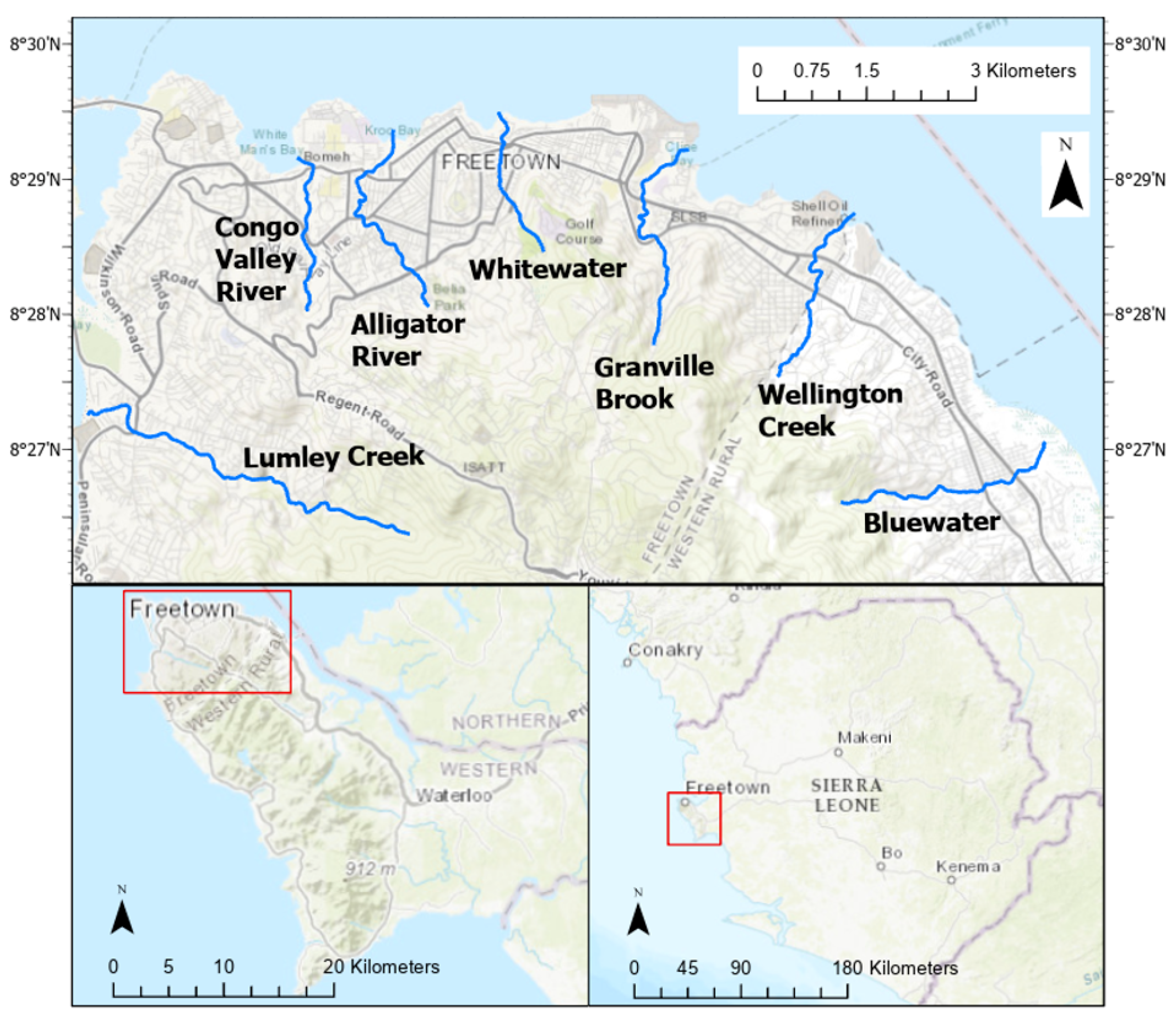
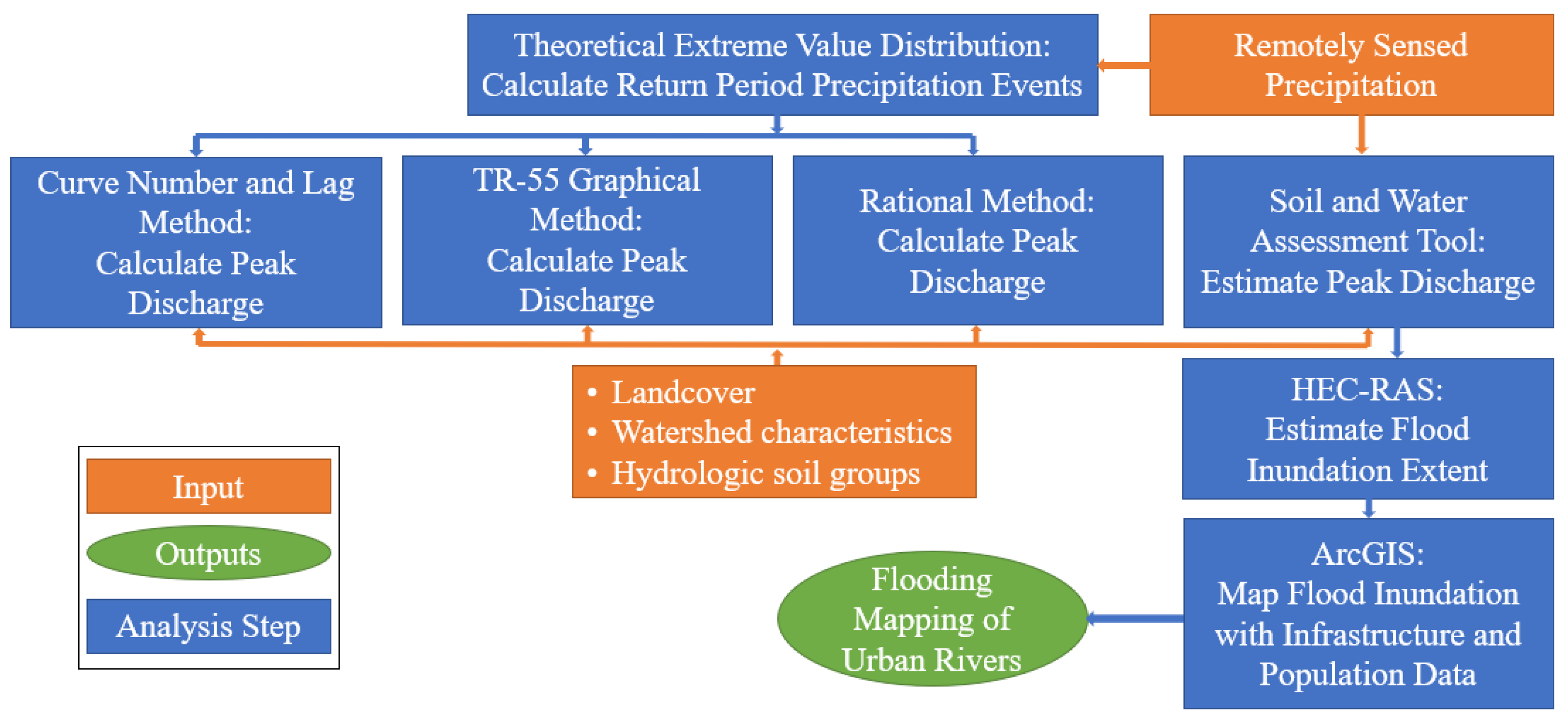
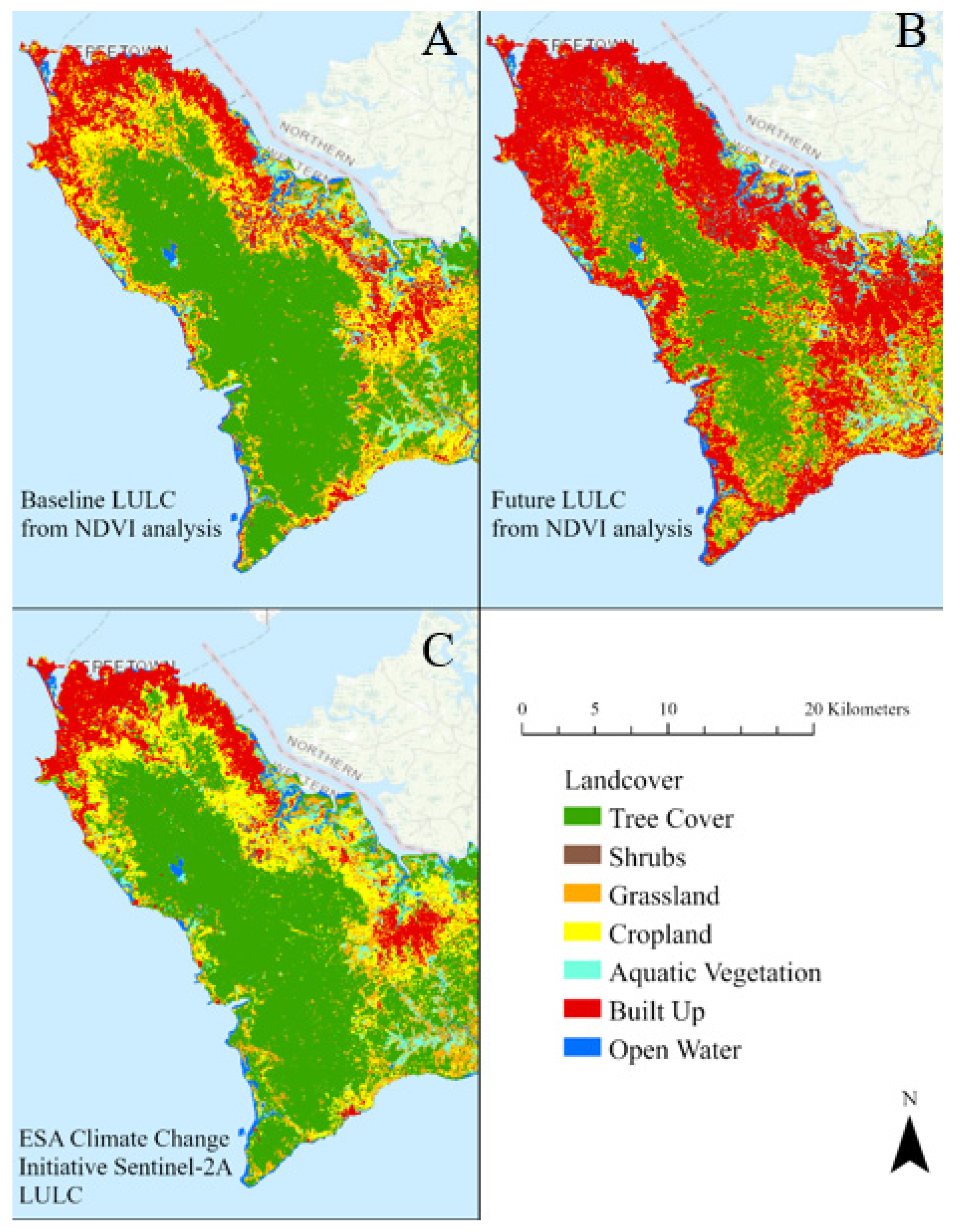
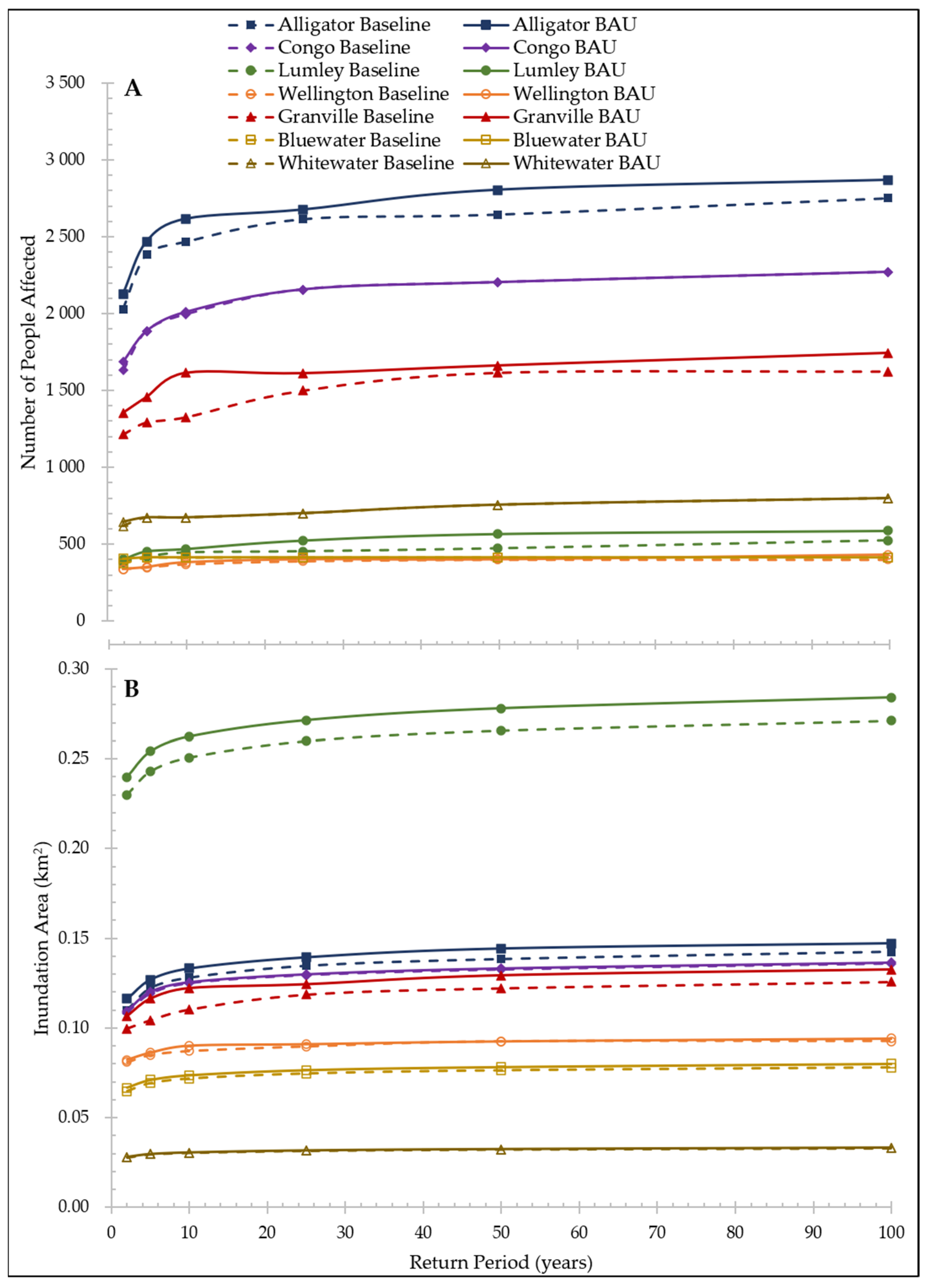
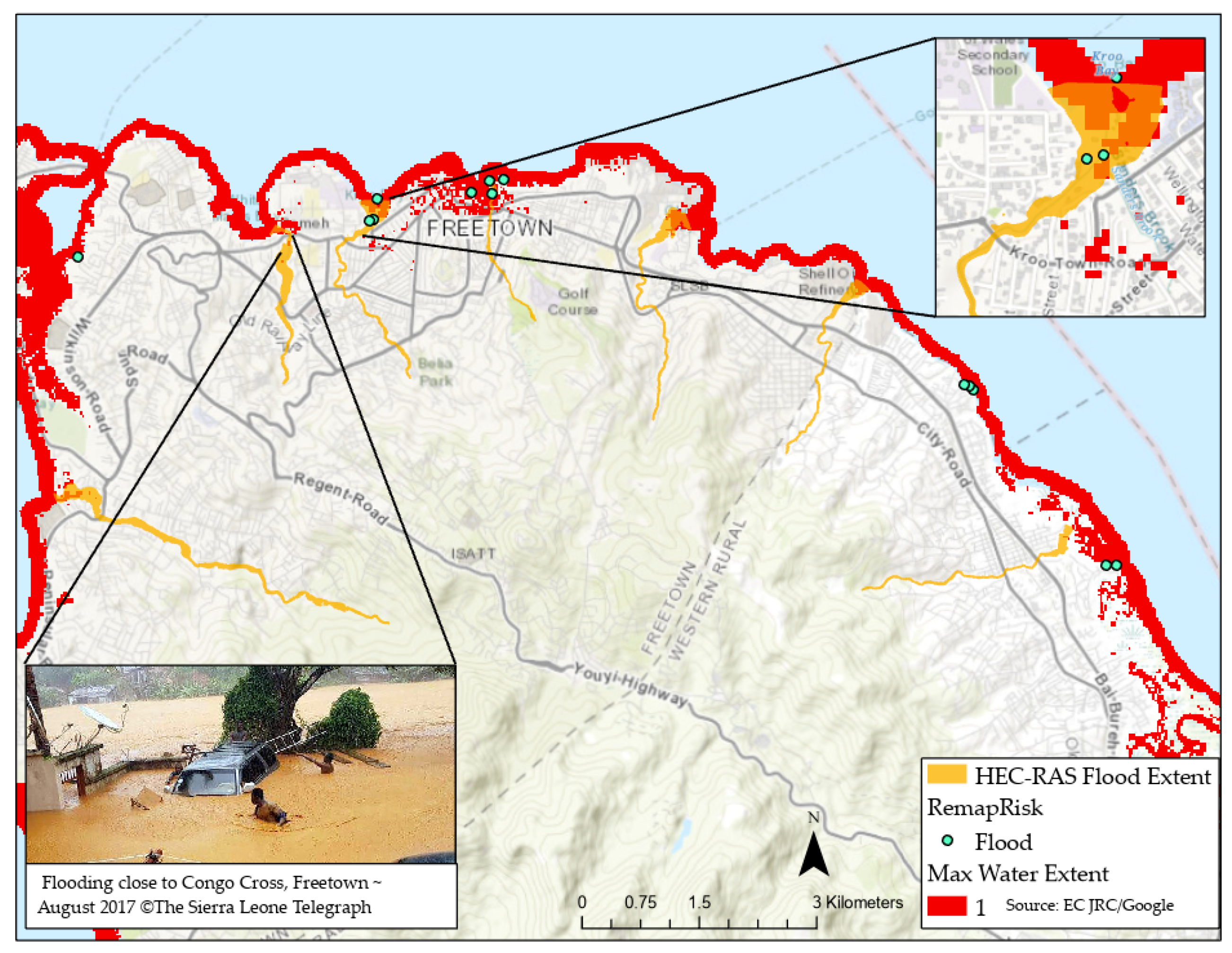
| Return Period (Year) | 2 | 5 | 10 | 25 | 50 | 100 |
|---|---|---|---|---|---|---|
| IMERG | 20 | 23 | 25 | 28 | 30 | 32 |
| Observed | 25 | 33 | 37 | 43 | 48 | 52 |
| NDVI Value | LULC |
|---|---|
| ≤0.37 | Built Up |
| ≤0.55 | Cropland |
| ≤0.65 | Grassland |
| >0.65 | Tree Cover |
| Flow (m3/s) | ||||||
|---|---|---|---|---|---|---|
| Return Period (Year) | 2 | 5 | 10 | 25 | 50 | 100 |
| Lag method | 7.9 | 11.6 | 14.4 | 18.1 | 21.0 | 23.9 |
| Graphical TR-55 (III) | 2.5 | 4.0 | 5.2 | 6.7 | 7.9 | 9.2 |
| Rational | 1.3 | 1.6 | 1.7 | 1.9 | 2.0 | 2.2 |
| SWAT | 11.3 | 14.6 | 16.9 | 19.7 | 21.7 | 23.8 |
| Return Period (Year) | 2 | 5 | 10 | 25 | 50 | 100 | |
|---|---|---|---|---|---|---|---|
| Alligator River | Lag method | 9.1 | 13.4 | 16.6 | 20.8 | 24.2 | 27.6 |
| SWAT | 8.5 | 11.0 | 12.7 | 14.8 | 16.3 | 17.9 | |
| Congo Valley River | Lag method | 7.9 | 11.6 | 14.4 | 18.1 | 21.0 | 23.9 |
| SWAT | 11.3 | 14.6 | 16.9 | 19.7 | 21.7 | 23.8 | |
| Lumley Creek | Lag method | 6.6 | 10.9 | 14.2 | 18.9 | 22.7 | 26.6 |
| SWAT | 16.7 | 21.7 | 25.0 | 29.2 | 32.3 | 35.3 | |
| Wellington Creek | Lag method | 3.5 | 5.6 | 7.1 | 9.3 | 11.1 | 12.9 |
| SWAT | 6.2 | 8.0 | 9.2 | 10.8 | 11.9 | 13.0 | |
| Granville Brook | Lag method | 1.1 | 2.5 | 3.6 | 5.4 | 6.8 | 8.4 |
| SWAT | 8.7 | 11.3 | 13.0 | 15.2 | 16.8 | 18.4 | |
| Bluewater | Lag method | 1.6 | 3.0 | 4.2 | 5.8 | 7.2 | 8.7 |
| SWAT | 4.9 | 6.4 | 7.4 | 8.6 | 9.5 | 10.4 | |
| Whitewater | Lag method | 1.6 | 2.8 | 3.7 | 5.0 | 6.1 | 7.2 |
| SWAT | 2.7 | 3.6 | 4.1 | 4.8 | 5.3 | 5.8 | |
Publisher’s Note: MDPI stays neutral with regard to jurisdictional claims in published maps and institutional affiliations. |
© 2021 by the authors. Licensee MDPI, Basel, Switzerland. This article is an open access article distributed under the terms and conditions of the Creative Commons Attribution (CC BY) license (https://creativecommons.org/licenses/by/4.0/).
Share and Cite
Cotugno, A.; Smith, V.; Baker, T.; Srinivasan, R. A Framework for Calculating Peak Discharge and Flood Inundation in Ungauged Urban Watersheds Using Remotely Sensed Precipitation Data: A Case Study in Freetown, Sierra Leone. Remote Sens. 2021, 13, 3806. https://doi.org/10.3390/rs13193806
Cotugno A, Smith V, Baker T, Srinivasan R. A Framework for Calculating Peak Discharge and Flood Inundation in Ungauged Urban Watersheds Using Remotely Sensed Precipitation Data: A Case Study in Freetown, Sierra Leone. Remote Sensing. 2021; 13(19):3806. https://doi.org/10.3390/rs13193806
Chicago/Turabian StyleCotugno, Angela, Virginia Smith, Tracy Baker, and Raghavan Srinivasan. 2021. "A Framework for Calculating Peak Discharge and Flood Inundation in Ungauged Urban Watersheds Using Remotely Sensed Precipitation Data: A Case Study in Freetown, Sierra Leone" Remote Sensing 13, no. 19: 3806. https://doi.org/10.3390/rs13193806







